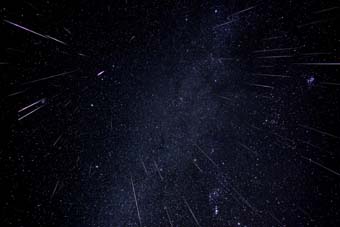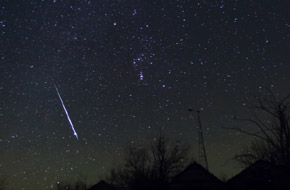
This photo shows Geminids streaming away from the shower's radiant near the star Castor. It was made by combining 83 out of 1,256 exposures shot over an 11-hour time span on December 13-14, 2004. Click above for a larger image.
Fred Bruenjes
August's Perseids and December's Geminids are the Old Faithfuls of meteor showers, putting on reliably strong displays year after year. Which one appears more spectacular depends largely on the phase of the Moon. This year a nearly full Moon made it hard to see the faintest Perseid meteors, but conditions are quite favorable for the Geminids. The Moon won't rise until roughly 1:30 a.m. on the night of December 13–14, when the meteor shower will be at its strongest. And even after moonrise, skyglow from the waning crescent should be only a minor problem as long as you face west, with your back to the Moon.
Meteor activity should be strongest around 11:00 December 14th, Universal Time. (6 a.m. EST or 3 a.m. PST). But the peak is fairly broad, so there should be plenty of meteors all night long. The number of meteors you'll actually see will depend more on the height of the radiant, which lies just a little west of Castor. At mid-northern latitudes, the radiant is well up in the sky by 9 p.m., and it's nearly at its highest just before moonrise, when you may see 100 meteors per hour. The rate should be about half that on the night of December 12–13, and although the shower usually falls off more quickly than it rises, there should still be residual activity on December 14-15.
Another incentive to stay outside at night is the possibility of northern lights. The huge sunspot complex 10930, which released one of the most powerful solar flares ever recorded on December 5th, produced another X-class flare early on December 13th. Material from that blast is due to reach Earth on December 14th, with an increased likelihood of auroral activity.

A bright meteor from the 2004 Geminids was captured with a tripod-mounted digital camera and a 16-mm lens.
The Geminids are unusual in several regards. Most meteor showers are associated with comets, but the parent body of the Geminid meteoroids is the asteroid 3200 Phaethon. Like most asteroids, but unlike the great majority of comets, Phaethon orbits the Sun in the same direction as Earth, and also in more or less the same plane. Phaethon is moving faster than Earth when it crosses our orbit, so the meteoroids that it generates approach our planet from behind. That means that they strike our atmosphere at a fairly low relative velocity. We strike most other meteoroid streams either at oblique angles or head-on, and the meteoroids within most streams are moving much faster than the Geminds, having "fallen" from the outer reaches of the solar system rather than the relatively nearby asteroid zone.
Because they're moving almost in unison with our planet, the Geminid meteors cross the sky at a slow, majestic pace compared to most meteors. And because they "catch" us from behind, they're visible in the evening sky — on Earth's trailing side in its orbit around the Sun — as well as in the morning sky, when most meteor showers are at their strongest.
So even though the Geminds happen near the coldest time of year for Northern-Hemisphere observers, they do offer the benefit of putting on a good show at a civilized hour, instead of requiring you to start observing after midnight, like the Leonids. You can even, with a clean conscience, use moonrise as an excuse to go to bed at 1:30 a.m. after enjoying several hours of great meteor watching. But make sure you bundle up! A lounge chair, sleeping bag, and warm winter hat are almost required equipment for observing the "Gems."
The best direction to watch is wherever your sky is darkest, at an angle of 45° or more above the horizon. Click here for more tips on meteor observing. And see Advanced Meteor Observing if you want to do a scientific meteor count — one worth reporting to the North American Meteor Network or the International Meteor Organization. It's easier than it sounds, and lots of fun.
 0
0
Comments
You must be logged in to post a comment.